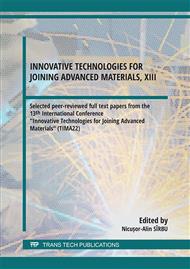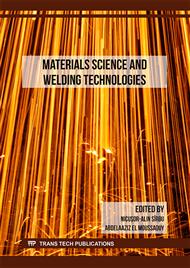[1]
Karadeniz E. Influence of different initial microstructure on the process of spheroidization in cold forging. Mater Des 2008;29:251–6.
DOI: 10.1016/j.matdes.2006.11.015
Google Scholar
[2]
Arivazhagan N, Singh S, Prakash S, Reddy GM. An assessment of hardness, impact strength, and hot corrosion behaviour of friction-welded dissimilar weldments between AISI 4140 and AISI 304. Int J Adv Manuf Technol 2008;39:679–89.
DOI: 10.1007/s00170-007-1266-7
Google Scholar
[3]
Demir T, Ubeyli M, Yildrim RO. Investigation on the ballistic impact behaviour of various alloys against 7.62 mm armour piercing projectile. Mater Des 2008;29:2009–16
Google Scholar
[4]
Rodriguez E, Flores M, Perez A, Mercado-Solis RD, González R, Rodríguez J, et al. Erosive wear by silica sand on AISI H13 and 4140 steels. Wear 2009;267:2109–15.
DOI: 10.1016/j.wear.2009.08.009
Google Scholar
[5]
Ilhan E, Findik F, Aslanlar S. An investigation of the factors affecting the design of drum dryers. Mater Des 2003;24:503–7.
DOI: 10.1016/s0261-3069(03)00108-0
Google Scholar
[6]
Nouari M, Molinari A. Experimental verification of a diffusion tool wear model using a 42CrMo4 steel with an uncoated cemented tungsten carbide at various cutting speeds. Wear 2005;259:1151–9.
DOI: 10.1016/j.wear.2005.02.081
Google Scholar
[7]
Starke P, Walther F, Eifler D. New fatigue life calculation method for quenched and tempered steel SAE 4140. Mater Sci Eng A 2009;523:246–52.
DOI: 10.1016/j.msea.2009.05.067
Google Scholar
[8]
Flori M, Gruzza B, Bideux L, Monier G, Robert-Goumet C. A study of the 42CrMo4 steel surface by quantitative XPS electron spectroscopy. Appl Surf Sci 2008;254:4738–43.
DOI: 10.1016/j.apsusc.2008.01.090
Google Scholar
[9]
Leslie WC. The physical metallurgy of steels. New York: McGraw-Hill; 1981.
Google Scholar
[10]
Philips TV, McCaffrey TJ. Ultrahigh-strength steels. Metals handbook, ASM; 1990. p.430
Google Scholar
[11]
Miokovic T, Schulze V, Vohringer O, Lohe D. Prediction of phase transformations during laser surface hardening of AISI 4140 including the effects of inhomogeneous austenite formation. Mater Sci Eng A 2006;435– 436:547–55.
DOI: 10.1016/j.msea.2006.07.037
Google Scholar
[12]
Nikitin I, Besel M. Correlation between residual stress and plastic strain amplitude during low cycle fatigue of mechanically surface treated austenitic stainless steel AISI 304 and ferritic–pearlitic steel SAE 1045. Mater Sci Eng A 2008;491:297–303.
DOI: 10.1016/j.msea.2008.03.034
Google Scholar
[13]
Miokovic T, Schulze V, Vohringer O, Lohe D. Influence of cyclic temperature changes on the microstructure of AISI 4140 after laser surface hardening. Acta Mater 2007;55:589–99.
DOI: 10.1016/j.actamat.2006.08.052
Google Scholar
[14]
Portolan E, Baumvol I, Figueroa C. Electronic structure and mechanical properties of plasma nitrided ferrous alloys. Appl Surf Sci 2009;255:6661–5.
DOI: 10.1016/j.apsusc.2009.02.081
Google Scholar
[15]
Lakhkar R, Shin Y, MJM K. Predictive modelling of multi-track laser hardening of AISI 4140 steel. Mater Sci Eng A 2008;480:209–17.
DOI: 10.1016/j.msea.2007.07.054
Google Scholar
[16]
Shah M, Salem M, Ahmad R, Zakaullah M, Qayyum A, Murtaz G. Langmuir probe characterization of nitrogen plasma for surface nitriding of AISI-4140 steel. J Mater Process Technol 2008;199:363–8.
DOI: 10.1016/j.jmatprotec.2007.08.025
Google Scholar
[17]
Miokovic T, Schulze V, Vohringer O, Löhe D. Prediction of phase transformations during laser surface hardening of AISI 4140 including the effects of inhomogeneous austenite formation. Mater Sci Eng A 2006;435:547–55.
DOI: 10.1016/j.msea.2006.07.037
Google Scholar
[18]
Ochoa E, Figueroa C, Alvarez F. The influence of the ion current density on plasma nitriding process. Surf Coat Technol 2005;200:2165–9.
DOI: 10.1016/j.surfcoat.2004.09.004
Google Scholar
[19]
Turk A, Ok O, Bindal C. Structural characterization of fluidized bed nitrided steels. Vacuum 2005;80:332–42.
DOI: 10.1016/j.vacuum.2005.06.001
Google Scholar
[20]
Alsaran A, Yildiz F, Celik A. Effects of post-ageing on wear and corrosion properties of nitrided AISI 4140 steel. Surf Coat Technol 2006;201:3147–54.
DOI: 10.1016/j.surfcoat.2006.06.033
Google Scholar
[21]
D. Chaouch, S. Guessasma, A. Sadok, Finite Element simulation coupled to optimisation stochastic process to assess the effect of heat treatment on the mechanical properties of 42CrMo4 steel, Materials & Design, Volume 34, 2012, Pages 679-684, ISSN 0261-3069.
DOI: 10.1016/j.matdes.2011.05.026
Google Scholar
[22]
Kurniawan, Rendi & Park, Gun Chul & Park, Ki & Yu, Zhen & Kwak, Ye In & Kim, Min & Lee, Jong & Ko, Tae Jo & Park, Chong-Sung. (2020). Machinability of modified Inconel 713C using a WC TiAlN-coated tool. Journal of Manufacturing Processes. 57. 409-430.
DOI: 10.1016/j.jmapro.2020.06.032
Google Scholar
[23]
Matysiak H, Zagorska M, Balkowiec A, Adamczyk-Cieslak B, Cygan R, Cwajna J, et al. The microstructure degradation of the in 713C nickel-based superalloy after the stress rupture tests. J Mater Eng Perform 2014; 23:3305–13. https://doi.org/10. 1007/s11665-014-1123-4.
DOI: 10.1007/s11665-014-1123-4
Google Scholar
[24]
Lee W-S, Su T-T. Mechanical properties and microstructural features of AISI 4340 high-strength alloy steel under quenched and tempered conditions. J Mater Process Technol 1999; 87: 198–206.
DOI: 10.1016/s0924-0136(98)00351-3
Google Scholar
[25]
Rajan KM, Deshpande PU, Narasimhan K. Effect of heat treatment of preform on the mechanical properties of flow formed AISI 4130 steel tubes – a theoretical and experimental assessment. J Mater Process Technol 2002;125– 126:503–11.
DOI: 10.1016/s0924-0136(02)00305-9
Google Scholar
[26]
Klotz U, Solenthaler C, Uggowitzer P. Martensitic–austenitic 9–12% Cr steels – alloy design, microstructural stability and mechanical properties. Mater Sci Eng A 2008;476:186–94.
DOI: 10.1016/j.msea.2007.04.093
Google Scholar



